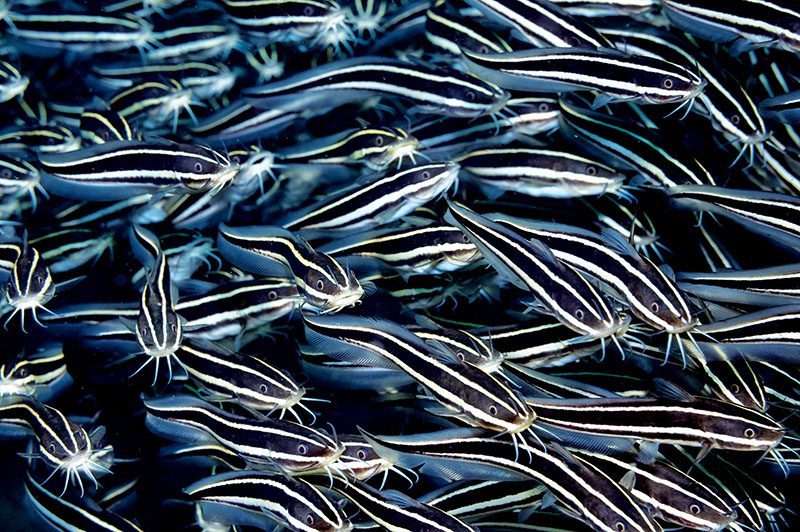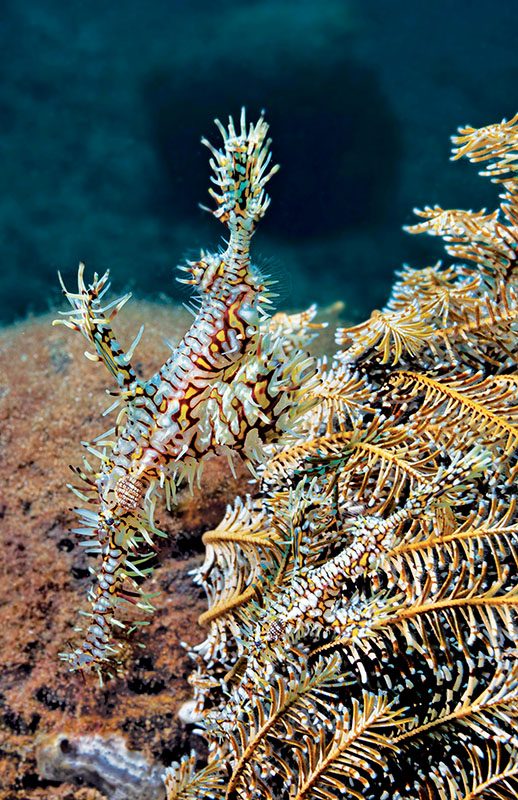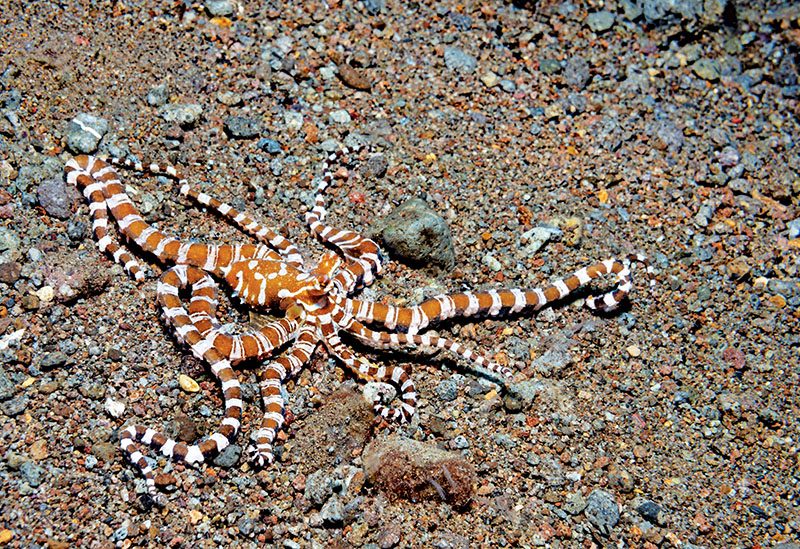Bayangkan diri Anda berada di atas perahu selam di laut biru tropis, bersiap-siap untuk menyelam bersama para ahli foto bawah air legendaris Marty Snyderman dan Michael Aw serta para master yang sangat berbakat dalam genre ini, Tanya Griffin Houppermans dan Vijay Raman. Pada titik tertentu dan karena satu dan lain hal, sebagian besar fotografer pernah mengalami tekanan untuk mendapatkan foto yang bagus. Anda mungkin menduga bahwa kami akan merasakan tekanan itu dan arus kompetisi yang nyata saat kami bersiap-siap di antara perusahaan yang mengesankan. Namun, selama waktu yang kami habiskan bersama kelompok yang luar biasa ini, ternyata tidak demikian.
Karena fotografer bawah air semakin banyak berbagi dunia bawah air mereka dengan fotografer lain yang sama bersemangatnya, dapat dimengerti bahwa beberapa orang mungkin berpikir bahwa para profesional foto bawah air lebih bertekad untuk memonopoli peluang foto terbaik. Tetapi kenyataannya adalah bahwa setiap fotografer profesional bawah air yang sepadan dengan f-stop mereka telah belajar untuk merangkul nilai kerja sama tim di kedalaman. Kerja sama tim tersebut melibatkan pengamatan beberapa panduan yang telah kami alami sebagai etika foto bawah air yang ditunjukkan oleh para profesional ini setiap kali mereka berada di dalam air.
Kolaborasi Versus Kompetisi
"Fotografi kelautan hanyalah bentuk lain dari fotografi, dan jika seseorang belajar lebih banyak dari apa yang telah dilakukan sebelumnya, di darat atau oleh para seniman hebat, ia dapat membawanya ke bawah air dan menciptakan gambar yang lebih baik."- Amos Nachoum
Sejak kami tiba di Filipina, tampak jelas bahwa semua orang mengecek ego mereka di pesawat. Semangat niat baik dan hubungan yang kuat di antara kontingen fotografer foto bawah air yang bertahan sepanjang perjalanan. Kami saling membantu satu sama lain untuk menemukan dan berbagi foto, bersosialisasi, dan bertukar pikiran mengenai perlengkapan dan teknik foto bawah air.
Kelimpahan atau Kelangkaan
"Anda akan mendapatkan semua yang Anda inginkan dalam hidup jika Anda membantu cukup banyak orang untuk mendapatkan apa yang mereka inginkan."- Zig Ziglar
Jika Anda memiliki pola pikir kelangkaan, Anda akan percaya bahwa hanya ada sedikit kesempatan untuk berfoto. Namun, ketika Anda membalikkan pemikiran tersebut untuk merangkul pola pikir kelimpahan, Anda akan segera menemukan bahwa selalu ada banyak kesempatan berfoto dan melihat kehidupan laut.

Berbagi Foto Ops
"Tujuan kami adalah untuk menangkap perilaku yang jarang terlihat dalam film. Dan triknya adalah dengan menghabiskan banyak waktu di bawah air."- Howard dan Michelle Hall
Batasi diri Anda hingga lima atau enam eksposur jika Anda atau pemandu selam menemukan makhluk yang fotogenik. Jika fotografer lain sedang menunggu untuk mengambil beberapa foto dari subjek yang sama, perlahan-lahan menjauhlah, posisikan diri Anda melawan arus, dan berhati-hatilah agar tidak mengotori pemandangan saat Anda berangkat. Ambil posisi dan tunggu dengan sabar untuk giliran Anda berikutnya. Jika Anda ingin mengabadikan perilaku tertentu, Anda tidak boleh membiarkan keinginan itu membuat Anda terburu-buru saat sesama fotografer mengambil gambar.
Menghormati dan Melindungi Kehidupan Laut
"Anda harus menjadi ikan di antara ikan-ikan untuk mempelajari lingkungan dan kehidupan mereka."- Hans dan Lotte Hass
Sebagian besar fotografer memahami bahwa melecehkan atau memanipulasi kehidupan laut untuk pembuatan gambar tidak dapat diterima. Sebaliknya, mereka mencari subjek yang berada dalam posisi yang menarik, idealnya dengan ruang negatif yang baik. Ingatlah bahwa kehadiran Anda dapat memberikan tekanan yang tidak perlu pada subjek Anda. Fotografer harus mempertimbangkan untuk membatasi jumlah gambar yang mereka ambil dari subjek apa pun untuk melindunginya dari beberapa semburan lampu kilat. Dapatkan foto yang Anda inginkan, lalu lanjutkan.


Strategi Pendekatan Kehidupan Laut
"Mendekatlah dengan aman. Saya menyebutnya sebagai visualisasi prediktif. Lihat dalam bayangan Anda, bagaimana bidikan akan terlihat, atur semua kontrol kamera dan strobo ketika makhluk itu cukup dekat, dan miliki kesadaran untuk menekan rana setelah Anda berada di zona bidikan."- Stephen Frink
Saat memotret kehidupan laut, sesuaikan kamera Anda saat Anda memikirkan bagaimana Anda akan mendekati subjek. Bergeraklah secara perlahan, sebaiknya pada suatu sudut daripada secara langsung, dan cobalah untuk menghindari memicu respons melawan atau melarikan diri dari subjek Anda. Menimbulkan bayangan atau menimbulkan gelombang tekanan dari gerakan Anda dapat mengejutkan hewan laut. Jika medan terumbu karang relatif terbuka, penyelam dapat menyebar untuk menjangkau lebih banyak area dan mungkin menemukan makhluk terumbu karang yang mungkin luput dari perhatian.
Menjaga Kesadaran Situasional
"Membangun kesadaran situasional tidak dilakukan dalam semalam, dan tidak diajarkan dalam kursus khusus apa pun. Sebaliknya, ini adalah sesuatu yang harus dikembangkan sendiri oleh setiap penyelam. Dalam banyak hal, ini adalah perbedaan utama antara penyelam yang baik dan penyelam yang hebat."- Thomas Grønfeldt Senger
Ketika memotret subjek, pastikan untuk secara rutin memeriksa apa yang terjadi di sekitar Anda. Pertahankan kesadaran situasional di sekeliling Anda dan apakah ada fotografer lain di sekitarnya yang sedang bersiap-siap untuk membidik atau memotret ke arah Anda.
Berusahalah untuk menghindari berenang ke dalam bidang pandang fotografer lain. Tetaplah sejajar atau di belakang kamera mereka saat mengamati kehidupan laut atau menunggu giliran Anda untuk mengambil gambar. Cobalah untuk berenang di belakang sesama fotografer, bukan di bawahnya, sehingga pernafasan Anda tidak menciptakan gelembung yang tidak diinginkan dalam pemandangan mereka.
Tongkat penunjuk kehidupan laut adalah alat bantu bawah air yang hebat selama Anda tidak membiarkan tongkat Anda menyelinap masuk ke dalam bidikan seseorang.
Beberapa fotografer bawah air menggunakan tendangan katak yang lembut alih-alih tendangan kepakan untuk menghindari pengadukan sedimen.

Patuhi Rencana Penyelaman
"Temukan sekelompok orang yang menantang dan menginspirasi Anda, habiskan banyak waktu bersama mereka, dan itu akan mengubah hidup Anda selamanya."- Amy Poehler
Tampaknya hal ini terjadi setiap saat: Anda hampir mengakhiri penyelaman, dan Anda menemukan subjek primo beberapa menit sebelum rencana penyelaman meminta semua orang muncul ke permukaan. Semua orang wajib mengakhiri penyelaman pada waktu yang telah disepakati. Tidak sopan jika terlambat dan membuat orang lain menunggu di atas permukaan. Lagi pula, mereka mungkin memiliki tempat tujuan, makan siang mungkin sedang menunggu, atau mereka mungkin memerlukan waktu interval permukaan tambahan untuk memecahkan masalah kerusakan sistem kamera.
Tunjukkan rasa hormat dengan mematuhi rencana penyelaman, sehingga Anda tidak memengaruhi orang lain dalam kelompok Anda. Jika Anda tidak dapat menghormati orang lain dengan mematuhi rencana penyelaman yang telah disepakati, pertimbangkan untuk menyewa pemandu selam dan perahu pribadi.
Simpati untuk Pemandu Selam
"Ya, saya bertahan dengan sedikit bantuan dari teman-teman saya."- The Beatles
Tidak ada yang bekerja lebih keras atau merasakan tekanan lebih besar untuk membantu fotografer bawah air mendapatkan foto yang bagus selain pemandu selam. Jangan memonopoli mereka; mereka harus bebas untuk berbagi bakat unik mereka di antara sesama fotografer bawah air. Bersikaplah baik, sopan, dan hormat, dan biarkan mereka melakukan keajaiban mereka. Mereka akan membantu Anda memotret kehidupan laut yang langka atau sulit dipahami. Jika Anda senang dengan layanan mereka, tunjukkan penghargaan Anda dengan memberikan hadiah yang murah hati, memberi mereka pujian dalam ulasan, memberi tahu atasan mereka, dan merekomendasikan mereka kepada teman-teman fotografer Anda.
Kerja Sama Tim Mewujudkan Impian
"Kekuatan tim adalah setiap anggota individu. Kekuatan setiap anggota adalah tim."- Phil Jackson
Orang lebih mungkin sukses bekerja sebagai tim daripada bersaing sebagai individu. Kapan pun Anda memiliki sekelompok rekan dengan tingkat kepercayaan yang tinggi ditambah dengan keinginan untuk menjalin hubungan yang saling menghormati, Anda akan benar-benar memahami bagaimana kerja sama tim dapat mewujudkan impian. Merangkul pemikiran ini memungkinkan Anda untuk menjadi warga laut yang baik selama upaya Anda untuk mendapatkan bidikan.
© Penyelam Siaga - Q1 2023